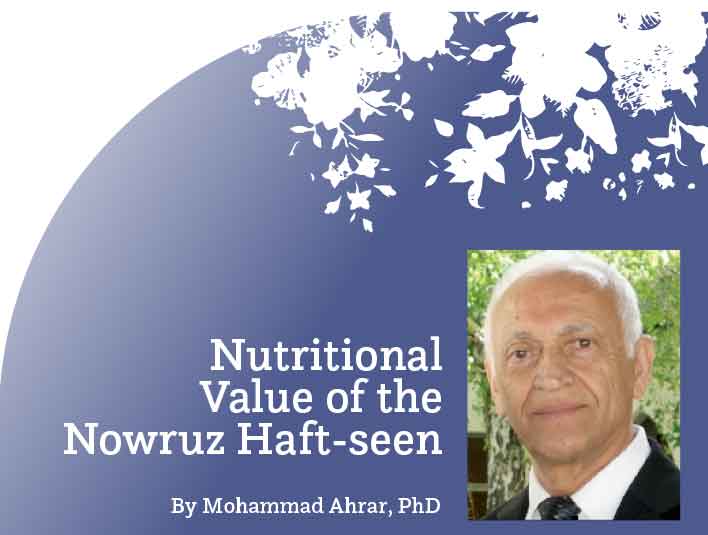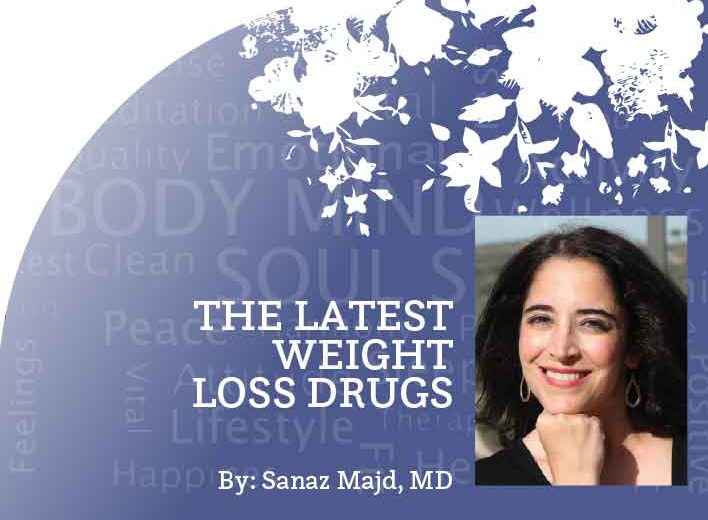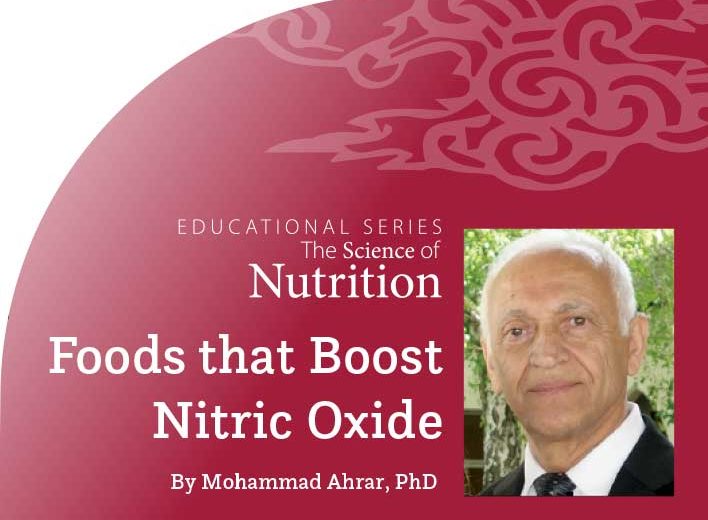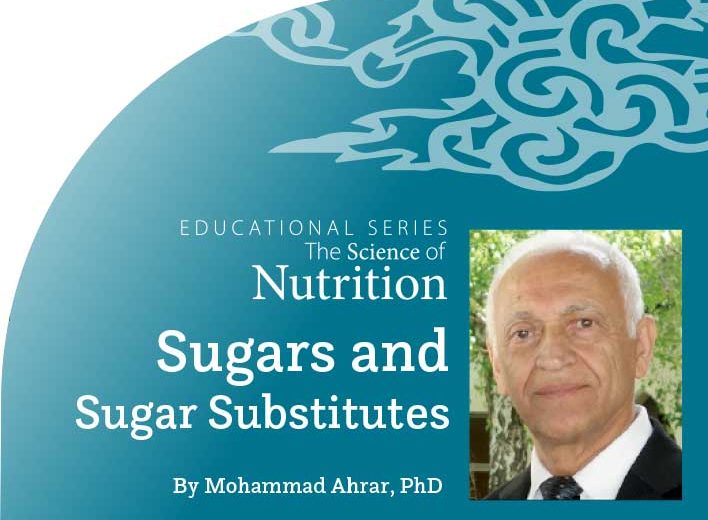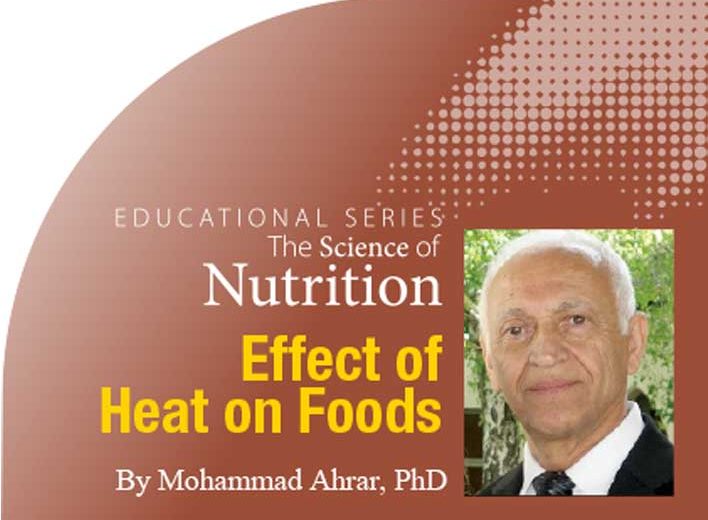Educational Series The Science of Nutrition
Nutritional Value of the Nowruz Haft-seen
By Mohammad Ahrar, PhD
Introduction
Nowruz, the start of the Iranian New Year, is celebrated by Iranians and the people of many other nations. One of the traditions during Nowruz is setting the haft-seen table. Seven natural foods whose names start with S, such as Sib (apple), define a haft-seen, which is also decorated with other food items, such as colored eggs, a mirror, candles, goldfish, coins, a hyacinth plant, a holy book or a famous poetry book, and of course, traditional sweets and pastries.
Although each item symbolizes a concept in Persian culture, certain items on the haft-seen table have great nutritional value. Some of the items were discussed in an earlier edition of Peyk. In this article, we will review the nutritional value of Sabzeh (wheat sprout), Sib (apple), and Seer (garlic).
 Sabzeh (Green Vegetation)
Sabzeh (Green Vegetation)
The most common green plate on the haft-seen table is Sabzeh, a plate of wheat sprouts that is usually grown to about 5 to 10 centimeters tall. Other types of seeds such as lentils, mung beans, and some other small seeds are also used as green plates in Nowruz households. Although not very palatable to human taste, the sprout has nutritional value. The process of sprouting the wheat grain multiplies its health benefits—germination breaks down some of the starch and also breaks down phytate, a form of phytic acid that normally decreases absorption of vitamins and minerals in the body. So, sprouted grains have more available nutrients than mature grains.
Vitamins One cup of sprouted wheat (about 108 grams) contains most of the B vitamins, including B6, thiamin, riboflavin, pantothenic acid, and niacin, in an amount that provides about 20% of the daily requirement for an average adult person.
Minerals Sprouted wheat provides a lot of minerals essential for health. One hundred grams of sprouted wheat provides about 2 mg. iron, 1.6 mg. zinc, 82 mg. magnesium, and 182 mg. potassium.
Proteins When wheat is soaked for 3 to 4 days and begins to sprout, it activates essential enzymes and the formation of quality proteins that supply essential amino acids. One serving of sprouted wheat (1 cup or 108 grams) provides 8 grams of good quality protein containing essential amino acids, such as histidine, isoleucine, leucine, lysine, methionine, phenylalanine, threonine, tryptophan, and valine. These amino acids are not synthesized by the human body and must be provided in the diet. (1)
Medical studies indicate that the moist environment during germination can promote bacterial growth. (2) For that reason, it is recommended that the seeds be washed several times before and after being soaked. The sprout is usually safer to eat when used in baked goods or cooked before adding them to a meal.
Sib (Apple)
Apple, a staple of the haft-seen table, is one of the most common fruits for human consumption, mainly due to its great nutritional value. Raw apples are rich in fiber, vitamins, minerals, and antioxidants, all of which benefit health.
Fiber A large whole apple provides about 4 grams of fiber, which is about 10-20 % of an average adult’s daily requirement. Studies have found that eating raw apples lowers levels of low-density lipoprotein cholesterol (so-called bad cholesterol). People who consume fruits high in fiber appear to have a lower risk of cardiovascular disease and stroke. Fiber may also help reduce the risk of colon cancer. Drinking apple juice that has no pulp does not have the same health benefits as the whole apple. (3)
Vitamin C An apple provides 9–11% of a person’s daily vitamin C needs. Vitamin C can boost the immune system and help defend the body from infections and diseases. Vitamin C is also a potent antioxidant. (More information about vitamin C can be found in Peyk #173).
Potassium Apples contain the most essential minerals in considerable amounts, including potassium, which helps relax the blood vessels, reducing the risk of high blood pressure and cardiovascular complications.
Antioxidants Apples also contain other types of antioxidants, such as quercetin and catechin. Antioxidants help neutralize free radicals that are produced in body cells. When free radicals accumulate in the body, they can damage the cells and cause a range of conditions, including cancer and diabetes. Consuming apples may help lower the risk of lung cancer, breast cancer, and colorectal cancer, as well as help brain function during old age. (3) More information about antioxidants can be found in Peyk #184.
Seer (Garlic)
Garlic is a popular ingredient in most Iranian dishes for its special taste and, more importantly, for its nutritional value. Closely related to onions, shallots, and leeks, garlic always makes an appearance on the haft-seen table.
Vitamins and MineralsOne clove (about 3 grams) of raw garlic provides a substantial amount of vitamin C, vitamin D, vitamin K, vitamin B6, and most other B vitamins. Garlic also provides necessary minerals for the body, including zinc, iron, potassium, and magnesium. It is also an excellent source of phosphorus, calcium, manganese, copper, and selenium. The phosphorus content of garlic plays a major role in energy production. Adenosine Triphosphate (ATP), referred to as the energy of life, consists of 3 phosphate groups. (4)
Immune System Garlic is known to boost the function of the immune system. Studies have found that a daily garlic supplement reduced the number of colds by 63% compared to a placebo. (4) Most of the health benefits of garlic are due to the presence of sulfur compounds, such as diallyl disulfide and allicin, which exert potent biological effects on the body cells. A four-week study on employees of a car battery plant (excessive exposure to lead) found that garlic reduced lead levels in the blood by 19%, and reduced many clinical signs of toxicity, including headaches and blood pressure. (4)
Cholesterol and Blood Pressure Research suggests that allicin in garlic may help lower blood pressure and keep it within a healthy range. In one study, garlic supplements in the diet of patients with high blood cholesterol reduced LDL cholesterol (known as bad cholesterol). (5) In adults with high blood pressure who took garlic supplements, the mean systolic blood pressure (the top number in a blood pressure reading) was around 8 points lower than those who took a placebo (sugar pill)—their diastolic blood pressure (the bottom number) was about 5 points lower. (5)
Antioxidant Properties Garlic contains antioxidants that support the body’s protective mechanisms against oxidative damage from free radicals. Perhaps the most famous benefits of garlic are due to its antioxidant allicin content, which is an unstable compound that is only present in fresh garlic after it has been cut or crushed. (5)
Alzheimer’s Risk Garlic’s effect on reducing cholesterol and blood pressure, combined with its antioxidant properties, help reduce the risk of common brain diseases like dementia and Alzheimer’s disease. (4)
Limitations of Use The sulfurous compounds in garlic, while beneficial in small doses, indicates its daily consumption should be limited. When garlic is ingested, the sulfur is absorbed by the digestive tract and reaches body cells and tissues, where it exerts its potent biological effects. However, the diallyl disulfide is decomposed in the human body into other compounds such as allyl methyl sulfide that is absorbed into the bloodstream and exits the body through the lungs and skin. As garlic and many other underground bulbs and tubers (such as onions and potatoes) concentrate nutrients, they may also concentrate toxins and pesticides. For this reason, organic garlic is preferable to garlic that has been grown in and around these poisonous substances.
Summary
All items on the haft-seen table have nutritional value. Wheat sprouts, apples, and garlic are no exception. Although all haft-seen foods have nutritional value and health benefit properties, they are normally consumed very little and should not be considered the main source of nutrients in diets.
References:
1- https://www.nutritionvalue.org/Wheat%2C_sprouted_nutritional_value.html
2- https://www.health.harvard.edu/blog/sprouted-grains-nutritious-regular-whole-grains-2017110612692
3- https://www.health.com/apples-benefits-7643492#:~:text=A%20Quick%20Review,disease%2C%20and%20type%202%20diabetes
4- https://www.healthline.com/nutrition/11-proven-health-benefits-of-garlic#TOC_TITLE_HDR_3
5- https://www.verywellhealth.com/the-benefits-of-allicin-88606#citation-36

